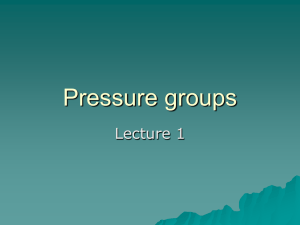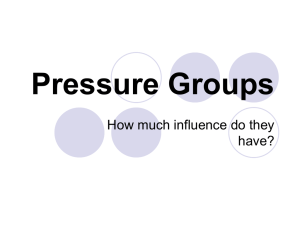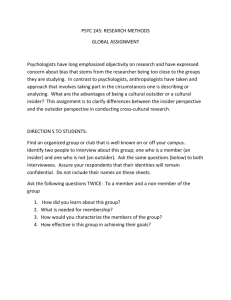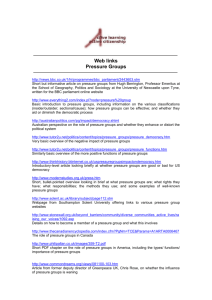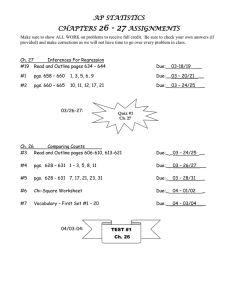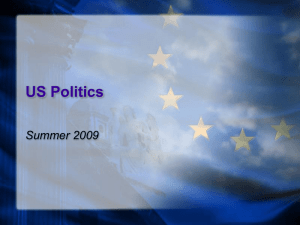Pressure groups
advertisement
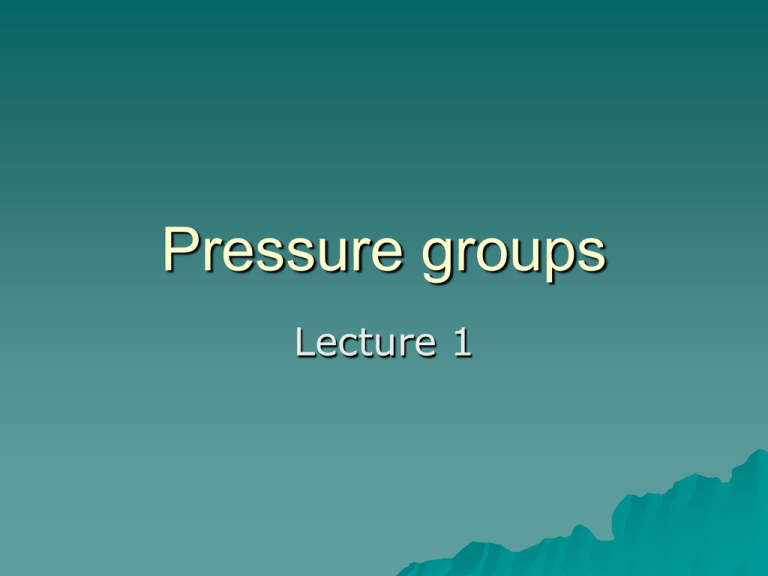
Pressure groups Lecture 1 What do we mean by a p/group? ‘The field of organized groups possessing both formal structure and real common interests in so far as they influence the decisions of public bodies’ (W J M Mackenzie) Some group activity directed at private bodies, but still relatively limited Social movements may not have a formal structure and are usually united by ideas not interests Differ from parties Party wants to win control of government or at least a share of office to implement policies Parties are broad coalitions that have to aggregate interests, groups often single issue Parties run candidates in elections, but note ‘interest parties’ Social movements approach (1) Literature in sociology Represent people with an outsider orientation Seek to change elements in the existing power structure Often use direct action methods Opposed to conventional power politics Social movements approach (2) Do not want to influence state, want to act in civil society Loosely defined organisational structure Either lack clearly defined leadership or have charismatic leader Often left of centre, lifestyle politics, but note petrol protests Changing terminology A search for ‘hurrah words’ to describe pressure or interest groups Stakeholders – used by government and EU Non-governmental organisations (originated with UN) Campaigning groups Advocacy groups What’s in a name? We don’t want to restrict your choice of group You can study international organisations or from country other than UK – but need understanding You can study direct action groups Key consideration is feasibility – is there enough material Step 1: check out web site Web site design (1) Does it download reasonably quickly? Is the site design coherent? Is it uncluttered? Is the meaning of categories clear? Can you find what you want quickly and easily? How would the site appear to someone wanting to get involved? Web site design (2) Can you join on line or download a membership form? Can you find out how to get involved in campaigns? Are illustrations relevant and appealing? Podcasts or videos? Has it been updated recently? Balance of question Approximate division between two parts of question is one third/two thirds Assessment of group effectiveness is core of second part of question You will be given credit for examining methodological problems of assessing effectiveness PGs and democracy – in favour Additional route for political participation, allowing citizens to develop political skills Increasing sense of involvement in politics and responsiveness of process, reducing alienation May counter political exclusion at a time when more conventional forms of participation are declining PGs and Democracy – in favour (2) Allow diversity of opinions to be expressed which is important as society becomes more diverse – more ‘fine grained’ views than those of political parties Allow the intensity of opinions to be expressed so that democracy is more than a ‘head counting’ exercise PGs and democracy – in favour (3) Provide information to government about public concerns – conduit of information Provide expertise not easily available to government or only at disproportionate cost, leading to better decision-making Consistent with basic democratic norm of freedom of association PGs and democracy – against (1) Extent of participation is often very limited in both quantity and quality Involvement may just be financial May be motivated by selective incentives Membership often very passive No greater engagement with civil society PGs and democracy – against (2) Groups often lack internal democracy, very hierarchical, run almost as businesses Hence opportunities for participation may be limited Over represent educated and affluent, hence increase rather than decrease political exclusion PGs and democracy – against (3) May be fronts for business activities, a lack of transparency Patient groups are coy about how much money they receive from pharmaceutical companies, but at least half do Lobbying for (expensive) drugs sold by companies to treat particular conditions PGs and democracy – against (4) Fragment the political process, especially ‘single issue’ groups Arouse expectations that cannot be met, fuelling cynicism Do not aggregate demands – do not have choose between priorities or consider opportunity costs of policies Summary of concerns Using language of Gerry Stoker Participatory failure – not engaging many citizens effectively Reinforcement of (social) bias Undermining effective governance by increasing polarisation See book chapter on website for elaboration of these arguments How can we categorise pressure groups? Insider/outsider groups cuts across traditional sectional/cause distinction arguing that was helpful but insufficient Insider groups recognised as legitimate by government But had to abide by rules of the political game which imposed constraints Outsider groups A more disparate category Include ‘would be’ insider groups, outsider groups by necessity Ideological or protest groups who do not want to be drawn into embrace of government Implication of typology that insider groups more likely to succeed – but not always Aberdeen Group modify typology Core insiders dealing with a broad range of issues Specialist insiders in policy niches Peripheral insiders, little influence Criticisms of typology One can pursue both strategies simultaneously – Greenpeace But does set up tensions within a group, Greenpeace very hierarchical and hence can control them In some areas now insider and outsider groups – National Farmers Union and Farmers for Action Easy to become an insider Insider groups number outsiders by 9:1 Not that hard to be placed on a consultation list. Blair Govt. has consultation code Internet lowers costs of formation, mobilisation and involvement Being involved in consultation is not same as real access to policy makers Most important criticism Nature of politics has changed, leading to changes in nature of pressure group activity Outsider groups becoming more successful, hence undermining one of key points of distinction Growth of direct action
